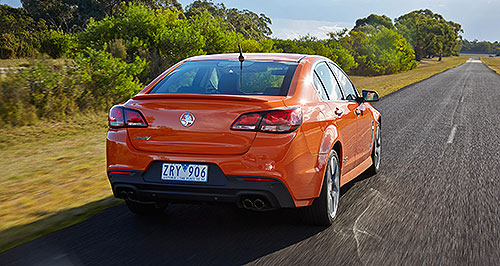News - Holden - CommodoreCommodore ready to ditch the driverCan I drive?: The technology needed to reduce the Commodore’s driver to little more than a passenger is already here. New Commodore’s parts bin is so advanced Holden could build a driverless car31 May 2013 By BARRY PARK HOLDEN’S Commodore is so advanced that a self-driving version of the large family car is now within grasp, one of its architects says. Mike Simcoe, the head of Holden’s design team and one of the main people behind the new-look Commodore, said the technology available to the large family car as part of the radical overhaul of its electronics would allow it to build a driverless vehicle. “All the technology we need to build a driverless car is already there,” Mr Simcoe said“We can build the Commodore as a driverless car today if we wanted, but the big question is, would you really want to jump behind the wheel of one? I don’t,” he said. The VF Holden, fully revealed this week, is the most technologically advanced Australian-made car, and features a host of features that help drivers stay safe on the road. This includes a forward-looking camera that can warn the driver if the car gets too close to the one in front, and a system that arcs up if the Commodore starts to stray out of its lane. However, extra functionality, such as automatic braking when the Commodore senses a collision is about to happen, and using the electric steering to nudge the car back into the right lane if it wanders outside are not on the radar. “I’m not sure what we’ve got (in the VF Commodore) is capable of that, but I’ve definitely heard of it in the process of things occurring,” Joe Sawyer, Holden’s electrical engineering group manager, said. “You read all the science magazines and all that stuff is going to come eventually. “I’m not sure I’m going to like it,” Mr Sawyer said. The US Department of Transportation overnight released a series of guidelines for car-makers that map out how they should develop self-driving car technology, but limiting their use to testing, not showrooms. "Whether we're talking about automated features in cars today or fully automated vehicles of the future, our top priority is to ensure these vehicles – and their occupants – are safe," National Highway Transport Safety Administration secretary Ray LaHood said. "Our research covers all levels of automation, including advances like automatic braking that may save lives in the near term, while the recommendations to states help them better oversee self-driving vehicle development, which holds promising long-term safety benefits."The department has split its definition of autonomous vehicles into five distinct bands ranging from no automation, through to electronic stability control, a combination of technologies such as adaptive cruise control with lane diversion technology, the Google car, and finally a fully self-driving car where the driver provides a destination from either inside – or outside – the car. The NHTSA said it was researching self-driving vehicles “so that the agency has the tools to establish standards for these vehicles, should the vehicles become commercially available”. However, it will be a long wait. The first phase of research is expected to be completed within the next four years, the NHTSA says.  Read more |
Click to shareHolden articlesCommodore pricing
Motor industry news |















Facebook Twitter Instagram